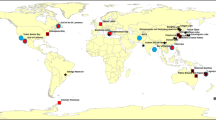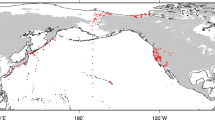Abstract
The performances of three semi-analytical retrieval models for water inherent optical properties were validated in the coastal Yellow Sea and East China Sea, including the Quasi-Analytical Algorithm (QAA), the Garver-Siegel-Maritorena model (GSM) and the Over Constrained Linear Matrix (LM). The model-retrieved parameters, namely absorption coefficients of phytoplankton (a ph), colored dissolved and detrital particulate matter (a dg), total absorption coefficients (a t), and backscattering coefficient of particles (b bp), were compared. The bio-optical datasets collected from a Yellow Sea and East China Sea cruise in April and September 2003 were used in the study. The QAA model performed the best in retrieval for all the coefficients, showing log-transformed root mean square errors of 0.306 for a ph, 0.268 for a dg, 0.144 for a t, and 0.273 for b bp at 443 nm. The LM model showed a slightly larger deviation than the QAA model with a similar error trend for absorption coefficients, but it returned the largest uncertainties for b bp, with log-transformed root mean square error up to 0.646. The GSM model, however, yielded the largest and fluctuating errors along with wavelength for absorption coefficient retrievals. Substituting the fitting parameters from measured data for the empirical spectral parameters, all three models returned better results. These improvements demonstrated that semi-analytical algorithms designed for ocean water need regional modifications before applying to coastal areas. The QAA algorithm may be the most suitable model for retrieval for the Yellow Sea and East China Sea, and future model refinements should concentrate on regional modeling of inherent optical properties.







Similar content being viewed by others
References
Bricaud A, Mejia C, Patissier DB et al (2007) Retrieval of pigment concentrations and size structure of algal populations from their absorption spectra using multilayered perceptrons. Appl Opt 46(8):1251–1260
Campbell JW (1995) The lognormal distribution as a model for bio-optical variability in the sea. J Geophys Res 100:13237–13254
Carder KL, Chen FR, Lee ZP et al (1999) Semianalytic Moderate-Resolution Imaging Spectrometer algorithms for chlorophyll a and absorption with bio-optical domains based on nitrate-depletion temperatures. J Geophys Res 104(C3):5403–5421. doi:10.1029/1998jc900082
Costa GP, Icely J, Cristina S, Newton A, Moore G, Cordeiro C (2013) Specific absorption coefficient of phytoplankton off the Southwest coast of the Iberian Peninsula: a contribution to algorithm development for ocean colour remote sensing. Cont Shelf Res 52:119–132
Cui TW, Zhang J, Tang J et al (2010) Satellite retrieval of inherent optical properties in the turbid waters of the Yellow Sea and the East China Sea. Chin Opt Lett 8(8):721–725
Ferrari GM, Bo FG, Babin M (2003) Geo-chemical and optical characterizations of suspended matter in European coastal waters. Estuar Coast Shelf Sci 57(1–2):17–24
Gao X, Song J (2005) Phytoplankton distributions and their relationship with the environment in the Changjiang Estuary, China. Mar Pollut Bull 50(3):327–335. doi:10.1016/j.marpolbul.2004.11.004
Garver SA, Siegel DA (1997) Inherent optical property inversion of ocean color spectra and its biogeochemical interpretation 1. Time series from the Sargasso Sea. J Geophys Res 102(C8):18607–18625
Gordon HR, Brown OB, Evans RH et al (1988) A semi-analytical radiance model of ocean color. J Geophys Res 93(20):10909–10924
HOBI-labs Inc. (2003) Backscattering Sensor Calibration manual (Revision J). Available at www.hobilabs.com
Hoge FE, Lyon PE (1996) Satellite retrieval of inherent optical properties by linear matrix inversion of oceanic radiance models:an analysis of model and radiance measurement errors. J Geophys Res 101(C7):16631–16648
Hooker SB, Maritorena S (2000) An evaluation of oceanographic radiometers and deployment methodologies. J Atmos Ocean Technol 17:811–830
Hu LM, Lin T, Shi XF, Yang ZS, Wang HJ, Zhang G et al (2011) The role of shelf mud depositional process and large river inputs on the fate of organochlorine pesticides in sediments of the Yellow and East China seas. Geophys Res Lett 38:L03602. doi:10.1029/2010GL045723
Huang D, Zhang T, Zhou F (2010) Sea-surface temperature fronts in the Yellow and East China Seas from TRMM microwave imager data. Deep Sea Res Part II 57:1017–1024
IOCCG (2006) Remote sensing of inherent optical properties: Fundamentals, tests of algorithms, and applications. Lee Z P, Reports of the International Ocean-Color Coordinating Group, No. 5
Le CF, Li YM, Zha Y et al (2009) Validation of a quasi-analytical algorithm for highly turbid eutrophic water of Meiliang Bay in Taihu Lake, China. IEEE Trans Geosci Remote Sens 47(8):2492–2500
Lee ZP, Carder KL (2004) Absorption spectrum of phytoplankton pigments derived from hyperspectral remote-sensing reflectance. Remote Sens Environ 89(3):361–368
Lee ZP, Carder KL, Arnone RA (2002) Deriving inherent optical properties from water color: a multiband quasi-analytical algorithm for optically deep waters. Appl Opt 41(27):5755–5772
Lee ZP, Weidemann A, Kindle J, Arnone R, Carder KL, Davis C (2007) Euphotic zone depth: its derivation and implication to ocean-color remote sensing (QAA-V4). J Geophys Res 112:C03009
Lee ZP, Lubac B, Werdell J, Arnone R (2009) An update of the Quasi-Analytical Algorithm (QAA_v5). http://www.ioccg.org/groups/Software_OCA/QAA_v5.pdf
Maritorena S, Siegel David A, Peterson AR (2002) Optimization of a semianalytical ocean color model for global-scale applications. Appl Opt 41(15):2705–2714
Marra J, Trees CC, O’Reilly JE (2007) Phytoplankton pigment absorption: a strong predictor of primary productivity in the surface ocean. Deep Sea Res 54:155–163
Matsuoka A, Hooker SB, Bricaud A, Gentili B, Babin M (2013) Estimating absorption coefficients of colored dissolved organic matter (CDOM) using a semi-analytical algorithm for southern Beaufort Sea waters: application to deriving concentrations of dissolved organic carbon from space. Biogeosciences 10:917–927
Mélin F, Zibordi G, Berthon JF (2007) Assessment of satellite ocean color products at a coastal site. Remote Sens Environ 110(2):192–215
Morel A (1974) Optical properties of pure water and pure sea water. In: Jerlov NG, Nielsen ES (eds) Optical aspects of oceanography. Academic, New York, pp 1–24
Morel A (1988) Optical modeling of the upper ocean in relation to its biogenous matter content case I waters. J Geophys Res Oceans 93(C9):10749–10768
Mouw CB, Yoder JA, Doney SC (2012) Impact of phytoplankton community size on a linked global ocean optical and ecosystem model. J Mar Syst 89(1):61–75. doi:10.1016/j.jmarsys.2011.08.002
Nagamani PV, Chauhan P, Sanwlani N (2011) Comparison of inherent optical properties (IOPs) in open and coastal waters of Arabian Sea using in-situ bio-optical data. J Indian Soc Remote Sens 39(4):455–462. doi:10.1007/s12524-011-0100-8
Pope R, Fry E (1997) Absorption spectrum (380–700 nm) of pure waters: II. Integrating cavity measurements. Appl Opt 36(33):8710–8723
Qing S, Tang J, Cui T et al (2011) Retrieval of inherent optical properties of the Yellow Sea and East China Sea using a quasi-analytical algorithm. Chin J Oceanol Limnol 29(1):33–45
Rehm E, McCormick NJ (2011) Inherent optical property estimation in deep waters. Opt Express 19(25):24986–25005
Roesler CS, Perry MJ (1995) In situ phytoplankton absorption, fluorescence emission, and particulate backscattering spectra determined from reflectance. J Geophys Res 100(C7):13279–13294
Roesler CS, Perry MJ, Carder KL (1989) Modeling in situ phytoplankton absorption from total absorption spectra in productive inland marine waters. Limnol Oceanogr 34(38):1510–1523
Shanmugam P, Ahn YH, Ryu JH et al (2010) An evaluation of inversion models for retrieval of inherent optical properties from Ocean color in coastal and open sea waters around Korea. J Oceanogr 66:815–830
Siegel DA, Maritorena S, Nelson NB (2002) Global distribution and dynamics of colored dissolved and detrital organic materials. J Geophys Res 107. doi:10.1029/2001JC000965
Siswanto E, Tang J, Yamaguchi H, Ahn Y-H, Ishizaka J, Yoo S, Kim S-W, Kiyomoto Y, Yamada K, Chiang C, Kawamura H (2011) Empirical ocean color algorithms to retrieve chlorophyll-a, total suspended matter, and colored dissolved organic matter absorption coefficient in the Yellow and East China Seas. J Oceanogr 67:627–650. doi:10.1007/s10872-011-0062-z
Song Q, Tang J (2006) The study on the scattering properties in the Huanghai Sea and East China Sea. Acta Oceanol Sin 28(4):57–63 (In Chinese with English abstract)
Song Q, Tang J, Ma R (2008) Correction of back scattering coefficients in different water bodies. Ocean Technol 27(1):48–52 (In Chinese with English abstract)
Tang J, Wang X, Song Q et al (2004) The statistic inversion algorithms of water constituents for the Huanghai Sea and the East China Sea. Acta Oceanol Sin 23:617–626 (In Chinese with English abstract)
Wang X, Tang J, Song Q et al (2006) A research on statistical retrieval algorithms and spectral characteristics of the total absorption coefficients in the Yellow Sea and the East China Sea. Chin J Oceanol Limnol 3:236–242
Wang W, Dong Q, Shang S et al (2009) An evaluation of two semi-analytical ocean color algorithms for waters of the South China Sea. J Trop oceanogr 28(5):36–42 (In Chinese with English abstract)
Westberry TK, Siegel DA, Subramaniam A (2005) An improved bio-optical model for the remote sensing of Trichodesmium spp blooms. J Geophys Res Oceans 110(C6). doi:C0601210.1029/2004jc002517
Yamaguchi H, Ishizaka J, Siswanto E, Son YB, Yoo S, Kiyomoto Y (2013) Seasonal and spring interannual variations of satellite-observed chlorophyll-a in the Yellow and East China Seas: New datasets with reduced interference from high concentration of resuspended sediment. Cont Shelf Res 59:1–9. doi:10.1016/j.csr.2013.03.009
Zhang M, Tang J, Dong Q, et al. (2010a) Backscattering ratio variation and its implications for studying particle composition: A case study in Yellow and East China seas. J Geophys Res Oceans 115(C12014). doi:10.1029/2010JC006098
Zhang M, Tang J, Dong Q et al (2010b) Retrieval of total suspended matter concentration in the Yellow and East China Seas from MODIS imagery. Remote Sens Environ 114(2):392–403. doi:10.1016/j.rse.2009.09.016
Acknowledgments
The authors are grateful to the members of field sample experiment team for their hard work in the Yellow Sea and East China Sea Spring and Autumn Cruises conducted by the National Satellite Ocean Application Service (NSOAS) and HY-l (first marine satellite of China, means Ocean-1) satellite ground application system. This work was funded by the NSFC projects (41331174, 41301366, 41071261, and 41023001).
Author information
Authors and Affiliations
Corresponding author
Rights and permissions
About this article
Cite this article
Huang, J., Chen, L., Chen, X. et al. Validation of semi-analytical inversion models for inherent optical properties from ocean color in coastal Yellow Sea and East China Sea. J Oceanogr 69, 713–725 (2013). https://doi.org/10.1007/s10872-013-0202-8
Received:
Revised:
Accepted:
Published:
Issue Date:
DOI: https://doi.org/10.1007/s10872-013-0202-8




